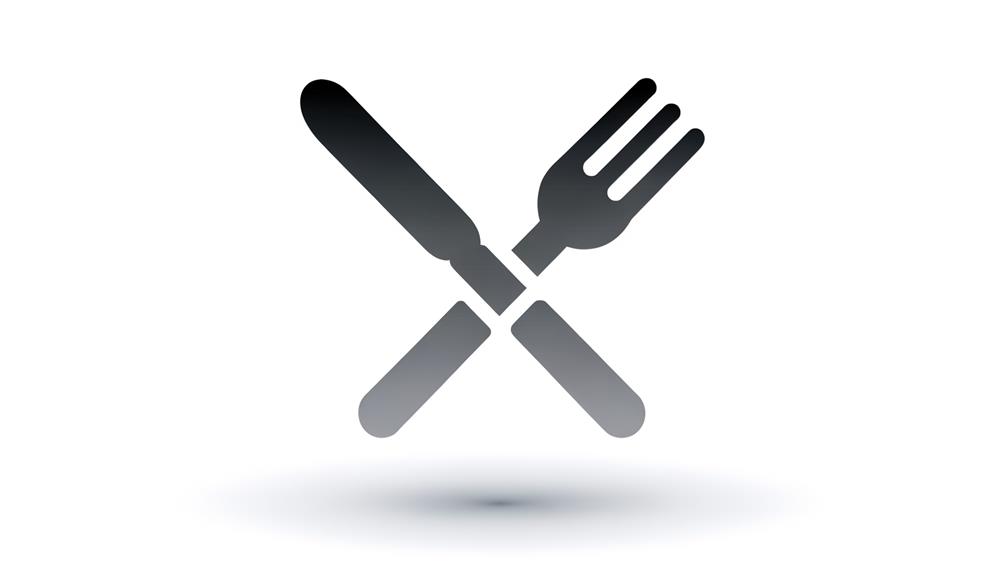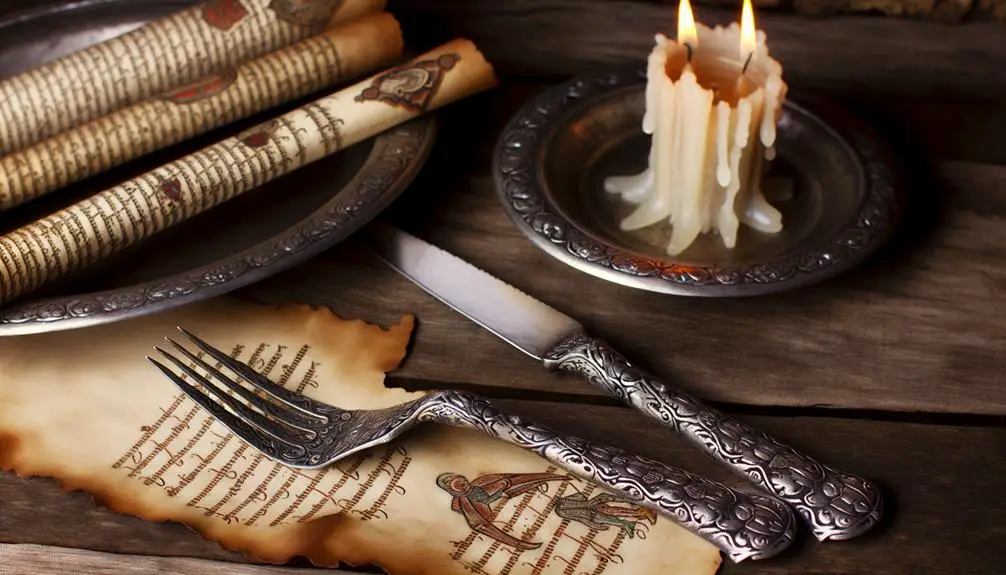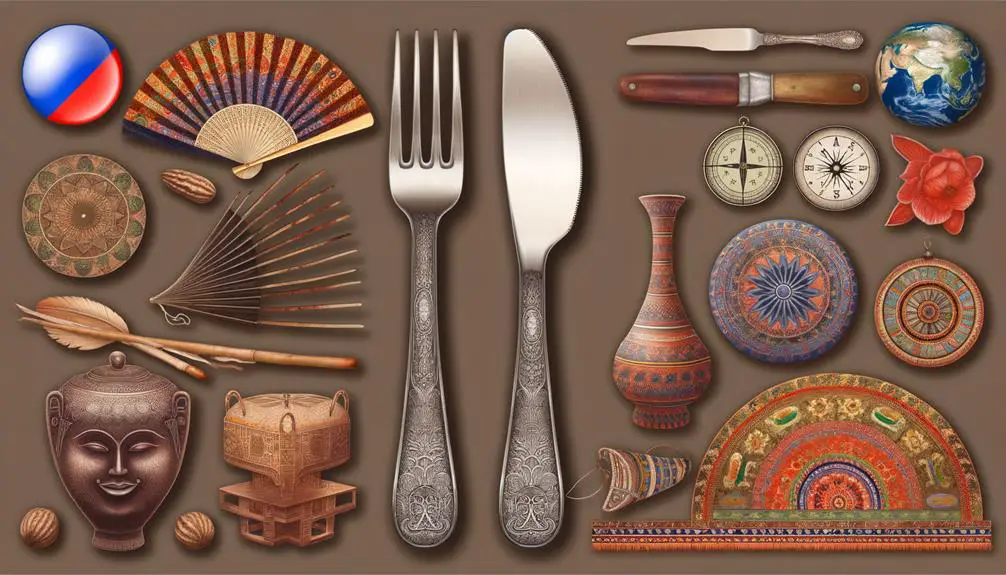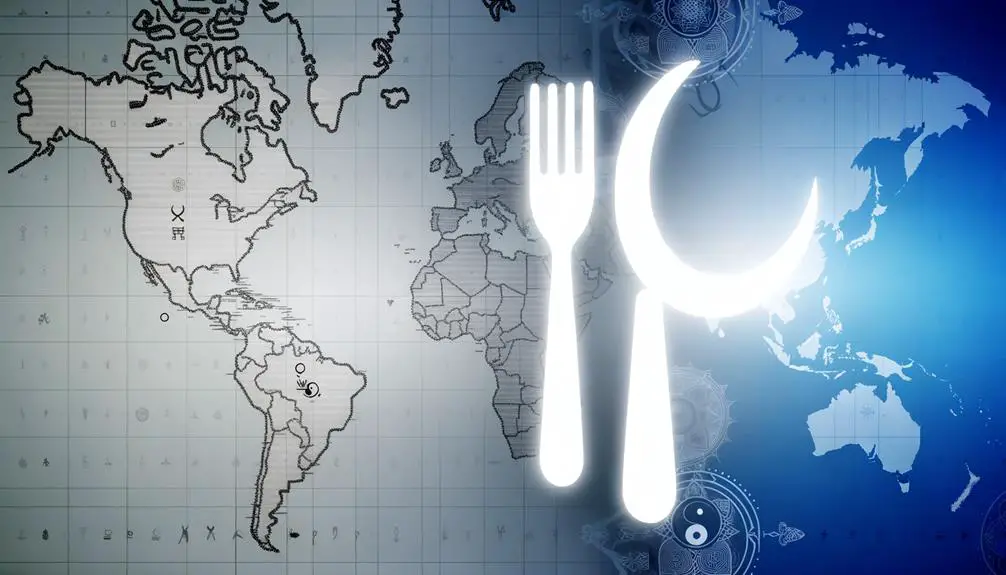What Is the Meaning of the Fork and Knife Symbol?
The fork and knife symbol holds a deep historical and cultural significance, evolving from ancient rites to signify power and refinement. In medieval Europe, these utensils were emblems of social order and ceremonial dining, later becoming markers of sophistication in European etiquette.
Globally recognized, this icon facilitates communication across cultural boundaries, embodying notions of hospitality and culinary civility. Its design has adapted to modern aesthetics, while still symbolizing the universal dining experience.
Through its rich legacy and evolving representation, the fork and knife icon continues to bridge cultures, history, and societal norms. To uncover further nuances, continue exploring.

Key Takeaways
- Represents dining customs and hospitality universally.
- Symbolizes sophistication and refinement in European dining etiquette.
- Denotes power, class, and social order historically.
- Reflects contemporary design trends emphasizing simplicity and clarity.
- Enhances intuitive navigation in dining-related services and apps.
Historical Origins

The historical origins of the fork and knife symbol can be traced back to ancient civilizations, where utensils were not only functional tools but also carried significant cultural and symbolic meanings.
In ancient Egypt, knives were primarily used for ceremonial purposes, symbolizing power and divinity. Meanwhile, the ancient Greeks and Romans employed knives and rudimentary forks in both dining and religious rituals, underscoring hospitality and communal harmony. Such utensils were often crafted from precious metals, highlighting their elevated status within society.
The symbolic representation of knives and forks evolved as markers of social order and refinement. These early uses infused the fork and knife with layers of meaning, intertwining practicality with deeper cultural narratives and societal values.
Evolution Over Time
How did the fork and knife, once symbols of power and ritual, evolve into commonplace dining tools reflecting societal shifts and cultural refinement?
Initially emblematic of aristocratic opulence, these utensils symbolized status and sophistication in medieval Europe. Forks, introduced by Byzantine nobility, gradually gained acceptance in Western Europe by the 16th century, despite initial resistance.
Knives, originally multi-functional tools, became specialized for dining as table etiquette evolved. By the 18th century, the widespread adoption of the fork and knife mirrored broader societal changes towards civility and order.
Their evolution from ceremonial objects to everyday implements underscores a shift towards democratization of dining practices, reflecting the transformation in social hierarchies and cultural norms over centuries.
Cultural Significance

The fork and knife hold significant cultural weight, particularly in the domain of European dining etiquette, where their proper use denotes sophistication and social status.
Historically, these utensils have also appeared in various works of art, often symbolizing themes of civilization and refinement.
European Dining Etiquette
Embedded within European dining etiquette, the use of the fork and knife transcends mere utility, embodying centuries-old traditions and societal norms that reflect cultural values and historical evolution.
Originating in the Byzantine Empire, the fork was initially met with resistance in Western Europe, symbolizing opulence and refinement. Over time, it became emblematic of civility and manners, aligning with the structured formality of European dining.
The knife, historically a tool for both eating and defense, evolved to signify trust and hospitality, particularly when placed on the table with the blade inward.
Together, these utensils not only facilitate eating but also serve as silent conveyors of respect, order, and communal harmony, mirroring the broader cultural emphasis on etiquette and social cohesion.
Symbolism in Art
Reflecting their functional and emblematic roles in dining etiquette, the fork and knife have also become profound symbols in art, representing themes of power, class, and social order.
Historically, these utensils were luxuries, often depicted in paintings to signify wealth and sophistication. During the Renaissance, artists used the fork and knife to illustrate the refinement of the upper classes, contrasting with the simplicity of peasant life.
In contemporary art, these symbols explore societal structures and human relationships, questioning the distribution of privilege and authority. By incorporating these everyday objects, artists invite viewers to reflect on their cultural and historical significance, offering a deeper understanding of how such symbols shape and reflect societal values and hierarchies.
Symbolism in Hospitality
The fork and knife have transcended their utilitarian functions to become symbols of universal dining etiquette, reflecting a shared understanding of hospitality across cultures.
Historically, these implements signify a societal evolution from communal to individualized dining practices, underscoring the importance of order and refinement in social settings.
Their cultural interpretations vary, yet they consistently embody the essence of gracious hospitality and the art of civilized eating.
Universal Dining Etiquette
In various cultures, the arrangement of a fork and knife on a plate is not merely utilitarian but a nuanced form of communication reflecting deep-rooted traditions and etiquette.
For instance, in European dining customs, placing the utensils parallel at the 4 o'clock position signifies that the diner has finished their meal, while crossing them in an X-shape indicates a pause.
These practices, steeped in history, convey respect and consideration for hosts and servers, transcending mere table manners.
The fork and knife, thereby, become symbolic gestures, silently communicating a diner's status and intentions.
This universal dining etiquette underscores a shared cultural language, fostering mutual understanding in social dining contexts across the globe.
Historical Significance
Throughout history, the placement and use of a fork and knife have evolved into powerful symbols within the domain of hospitality, reflecting societal values and cultural practices.
In medieval Europe, the fork was initially met with resistance, viewed as an extravagant utensil. Its eventual adoption signified a shift towards refined dining manners.
The knife, historically a personal item carried by diners, became a communal tool in the Renaissance, demonstrating trust and civility.
The formal arrangement of these utensils on a table came to symbolize order and respect for guests. This evolution underscores the fork and knife as more than mere dining tools; they are emblems of hospitality, denoting the host's attention to etiquette and the guest's honored status.
Cultural Interpretations
Across diverse cultures, the fork and knife have transcended their utilitarian roles to become potent symbols of hospitality and social norms.
In Western societies, the presentation of these utensils signifies a formal dining experience, reflecting respect and attentiveness to guests. Historically, elaborate table settings with forks and knives were a mark of sophistication and social status.
In Eastern cultures, however, where chopsticks dominate, the adoption of fork and knife symbolizes modernity and openness to global influences. The placement and handling of these utensils also carry symbolic weight; for instance, crossing them on a plate in European etiquette can denote a pause, while parallel placement signals completion.
These cultural interpretations reveal how simple tools can embody nuanced social values and traditions.
Global Recognition

The fork and knife symbol, universally recognized, holds varied cultural significances and historical depths that reveal its evolution and global acceptance.
Historically, the fork was introduced to Europe in the 11th century, while the knife has been a dining tool since prehistoric times. Their combined depiction as a symbol burgeoned in the 18th century, reflecting etiquette and dining customs.
Culturally, this iconography facilitates seamless communication across languages, representing food and hospitality worldwide, from Western fine dining to Eastern eateries. The symbol transcends linguistic barriers, providing an intuitive marker for dining facilities and culinary experiences.
Its global recognition underscores the shared human experience of dining, uniting diverse cultures through a common visual language.
Modern Design Trends
Incorporating sleek minimalism and adaptive functionality, modern design trends for the fork and knife symbol reflect contemporary aesthetics and technological advancements.
This evolution stems from a cultural shift towards simplicity and clarity, mirroring broader societal movements in design. Historically, these symbols were ornate and detailed, reflecting the grandeur of dining traditions.
Today, they have transformed into more streamlined forms, often rendered in monochromatic palettes with clean lines. This shift not only enhances visual clarity but also aligns with the digital age's emphasis on intuitive user interfaces.
The fork and knife symbol, once a mere indicator of dining, now embodies a blend of historical reverence and modern efficiency, capturing the essence of a rapidly evolving visual language.
Practical Applications

Utilizing the fork and knife symbol in various digital and physical interfaces underscores its practical significance in guiding users towards dining-related services and functionalities. This ubiquitous icon, steeped in historical context, transcends cultural boundaries, symbolizing nourishment and the social ritual of dining.
Its application is not merely decorative but functional, aiding intuitive navigation and enhancing user experience. Consider the following practical uses:
- Restaurant Locators: Instantly recognizable on maps, directing users to dining establishments.
- Food Delivery Apps: Simplifies the identification of food ordering options.
- Event Invitations: Denotes meal provision, creating anticipation for social gatherings.
- Travel Guides: Highlights culinary hotspots, enriching cultural exploration.
These applications demonstrate the fork and knife symbol's enduring relevance and universal appeal.
Conclusion
The fork and knife symbol, like a timeless tapestry, weaves together historical origins, cultural significance, and modern design trends into a cohesive narrative.
This enduring emblem transcends geographical boundaries, representing hospitality and shared human experiences. Its evolution mirrors societal changes, reflecting shifts in dining etiquette and global interconnectedness.
In modern contexts, the symbol continues to serve as a universally recognized icon, embodying the essence of communal dining and cultural heritage across diverse societies.





